If you’ve been to one of my prenatal or postnatal yoga classes you probably know that I have a particular interest in how movement affects the function of the pelvic floor. This interest developed out of my own experience with pelvic floor issues after the birth of my first son. I’m saving my personal story for a future blog post when I have the courage to write about it. For this post, I’ll skip ahead to give you the scoop (with photos) on the movement habits I changed to help me fix my pelvic floor issues.
First of all, I’d like to start by paying tribute to the pelvic floor, all pelvic floors, for what they have been doing for us without thanks or acknowledgement since before we could talk.
Your pelvic floor is made up of several muscles and is part of the foundation that is your core. It supports your pelvic organs (bladder, rectum, and uterus). It has always supported your organs whether you were conscious of it or not, whether you were practicing kegels or not. Your pelvic floor in conjunction with your other core muscles helps to stabilize the spine and pelvis to avoid back, pelvic and hip pain. While your pelvic floor must be strong enough to provide all of this support, it also has to be able to relax to let out urine and feces at the appropriate times. The pelvic floor also needs to relax to let things in (during sex, and for menstruation). And of course, it really needs to be able to relax when it is time for babies to make their way out!
If you didn’t notice the word “relax” in the last paragraph please go back and read it again.
So for your pelvic floor to be “functional” for all of the above jobs you can see that like other muscles it needs to be able to both contract and relax. The most common advice out there is to strengthen the pelvic floor through pelvic floor contraction or “kegel” exercises, which misses a big part of the picture of pelvic floor health. Pelvic floor dysfunction is often characterized by pelvic floor muscles that are highly toned. Weak does not always mean low tone. If you are experiencing symptoms such as stress incontinence (sneeze pee), pelvic organ prolapse, pelvic pain, painful sex, or other symptoms that may be related to pelvic floor weakness, I recommend visiting a pelvic health physiotherapist who can do an internal assessment to determine what treatment is recommended. If you are interested in personalized exercise sessions to help you create better awareness of your pelvic floor and core muscles, you can also book a private yoga & movement education session with me.
OK so where are the healthy movement habits I promised? Here you go.
- Stand with your weight over your heels.
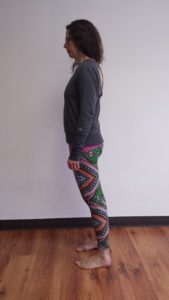
 The majority of clients I work with have a pelvis that is shifted well in front of their heels. This position doesn’t allow your gluteal (butt) muscles to activate. Your glute muscles help to keep the pelvic floor from shortening so when you stand with your pelvis forward your pelvic floor often ends up in a short and weak position. It also is hard on your back, hips, knees and feet to stand this way.
The majority of clients I work with have a pelvis that is shifted well in front of their heels. This position doesn’t allow your gluteal (butt) muscles to activate. Your glute muscles help to keep the pelvic floor from shortening so when you stand with your pelvis forward your pelvic floor often ends up in a short and weak position. It also is hard on your back, hips, knees and feet to stand this way.

 Without shoes on, start by backing your hips and pelvis up so that your legs are straight up and down and your weight is in your heels. Use a mirror and a belt or something to help you line up from the centre of your hip to the centre of your ankles. At first this might feel like a really odd position. If you feel that you are going to fall backwards, try sticking your butt out a little bit to bring your pelvis more neutral. Your toes may lift as they are no longer being forced into the floor by being asked to support too much of your body weight. Your muscles need time to adjust to this way of standing. This habit will take time to correct. Start by backing up as much as you can and bringing awareness to this way of standing. Slowly over time you will be able to get your weight back.
Without shoes on, start by backing your hips and pelvis up so that your legs are straight up and down and your weight is in your heels. Use a mirror and a belt or something to help you line up from the centre of your hip to the centre of your ankles. At first this might feel like a really odd position. If you feel that you are going to fall backwards, try sticking your butt out a little bit to bring your pelvis more neutral. Your toes may lift as they are no longer being forced into the floor by being asked to support too much of your body weight. Your muscles need time to adjust to this way of standing. This habit will take time to correct. Start by backing up as much as you can and bringing awareness to this way of standing. Slowly over time you will be able to get your weight back.
- Sit towards the front of your sitting bones.

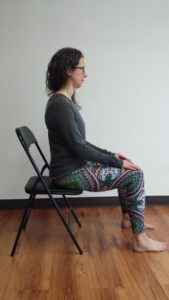 It is tempting to slouch into whatever you are sitting on (car seat, couch, chair). However, this position of tucking the pelvis while sitting pushes the tailbone in towards the centre of the pelvis. The tailbone is connected with your pelvic floor muscles and so this again shortens and weakens the pelvic floor. If you’re planning on birthing a baby at any point in the future you also don’t want to push your tailbone into that space so start now by sitting in a way that frees the tailbone.
It is tempting to slouch into whatever you are sitting on (car seat, couch, chair). However, this position of tucking the pelvis while sitting pushes the tailbone in towards the centre of the pelvis. The tailbone is connected with your pelvic floor muscles and so this again shortens and weakens the pelvic floor. If you’re planning on birthing a baby at any point in the future you also don’t want to push your tailbone into that space so start now by sitting in a way that frees the tailbone.
You want to sit towards the front of your sitting bones. Roll your pelvis forward and back on your chair until you can feel those little bones beneath you. Then sit towards the front edge of them so that more of your butt is behind rather than underneath you.
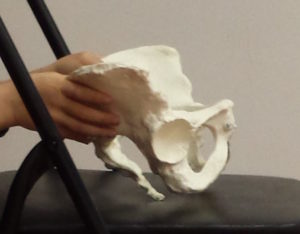
Ouch! Don’t sit on your tailbone!
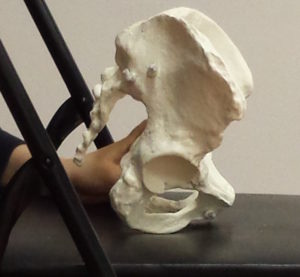
Ahh! Much better!
- Sit less. Walk more.
Excessive sitting is not good for your pelvic floor muscles. These muscles get plenty of exercise when you walk, especially if you walk in a way that uses your butt muscles. Try not to sit for long periods. If you work at a desk, get up and walk for a few minutes every 30-45 minutes. Try organizing walking meetings. Use part of your lunch break to go for a walk. If you do a lot of driving or a lot of cycling, try to substitute walking for some of your shorter trips.
- Flatten your shoes.
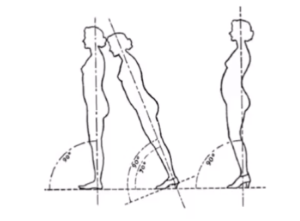
Shoes with a positive heel keep the muscles in the backs of your legs in a short position and result in the pelvis being taken out of neutral position and tucked instead. This pelvis position has the effect of shortening the pelvic floor muscles. Even most “flat” shoes have a slight rise in the heel. For the health of your pelvic floor start seeking out flatter shoes where the toes and heel are at the same level. If you’ve been wearing heeled and supported shoes for a long time, transitioning to minimal footwear is a process that will require work on foot mobility and strengthening. You can start by choosing the flattest shoes that you still find comfortable.
I hope you find these simple habit-changing suggestions useful. They can have a profound impact on the health of your pelvic floor. Drop me a line if you have any questions or comments and good luck!

P.S. – I am co-teaching a workshop on the Pelvic Floor on Sunday March 5th with Pelvic Floor Physiotherapist Kaeleigh Brown. The workshop is FULL but subscribe to my newsletter to find out about future workshops and classes for the Pelvic Floor!


